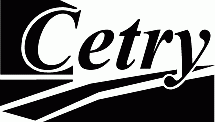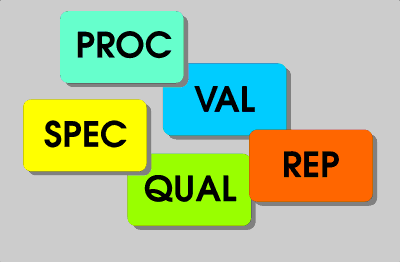
Examples of QA & RA Support
Cetry helps medical device manufacturers and their suppliers by means of problem solving, process modelling, characterization of product properties, device and materials qualification, process and manufacturing validation, related regulatory issues, quality assurance, and design and build of specialized equipment. Here follow some examples of past QA and RA activities conducted by Cetry.

List of Examples:
Related Pages
Refer to the SERVICES page for other Cetry activities.
Refer to the QA & RA support page for specific information about QA/RA services.
Setup of a QA/RA system for a starting medical device manufacturer
| • Client: | Starting medical device manufacturer |
| • Subject: | Product-to-market registration |
The new company sought to market a class 3 medical device as their first product. Manufacturing equipment was being built and product design was progressing. Cetry designed a quality assurance system that was able to accommodate regulatory requirements as set forth in the Medical Devices Directive (MDD 93/42/EEC). Risk analyses were done in combination with extensive product safety and functionality testing. Regulatory files were generated and plant audits were arranged with the Notified Body. The result was CE marking for a whole range of diagnostic catheters, both for cardiology and radiology.
return to top...
Conversion into an ISO13485-compatible system
| • Client: | Manufacturer of excipients |
| • Subject: | Alignment with ISO 13485 and certification |
The client's most important customer had let on that improvement of the QA system was believed to be a primary condition for sustained relations; it concerned projects related to excipients for medical implants. The projects would be lifted to a higher level if the client was able to provide sufficient quality assurance, preferably ISO 13485 compliant. Cetry was hired to reshape the existing quality system. This was a massive job, since it not only involved writing and implementing the required system procedures, but it also required a whole new culture withing the company. People who are used to working in one direction are often hard to be moved into an other. The conversion was done gradually, but at sufficient pace to keep their customers satisfied. Since then, all customer audits went well, and confidence in capability of the company grew. The ISO 13485 certification audit ended with three minor observations. By their mistake, the accredited body had omitted to perform a pre-audit, which undoubtedly would have led to even better results.
return to top...
Registration of a heparinized catheter as medical device
| • Client: | Major European manufacturer of diagnostic catheters |
| • Subject: | CE registration for heparinized diagnostic catheters |
This case consisted of building a design history file out of available data, and identifying and filling the gaps in relation to requlatroy requirements - i.e. MDD 93/42/EEC. Problem at the time was that it concerned the first case of a heparinized diagnostic cardiology catheter, which was a novelty to the Notified Body. However, there were other manufacturers with other medical devices that incorporated medicine, and the major question that had to be answered was: Is such a product a medical device or is it a medicinal device? In our case, the question was: Is this mainly a diagnostic catheter or is it a vehicle to deliver heparin? This question is not one to be answered by intention - it was clearly intended to be a diagnostic catheter - but by actual clinical impact. So, if the heparin played a major role in the clinical dynamics - think of significant increase of the patient's blood-clotting time - then the catheter would have to be considered a medicinal rather than a medical device. Activity of the heparin coating thus proved to be the key element for the heparinized catheter; in particular activity of heparin that might enter the blood-stream. Tests were deviced to quantify the heparin activity on the catheter (after sterilization) and the maximum amount of heparin that was expected to leach into the blood. This was then compared to known clinical situations, such as that of the standard heparin injection prior to catheterization. It was also understood that removal of the heparin-coated catheter would in turn remove the heparin action, save for the effects of the released heparin. Many questions were asked by the Notified Body, since they were members of a committee that was draughting the MEDDEV document on demarcation between medical and medicinal devices. "Heparinized catheter" made the top of the list as an example of a medical device aided by medicinal action.
return to top...
Build of a basic quality system for a supplier of medical materials
| • Client: | Developer and manufacturer of biodegradable materials for medical application |
| • Subject: | Basic quality system |
The client, a start-up company, lacked sufficient quality assurance to keep their customers satisfied. With customer audits coming, the client requested Cetry to build a basic quality assurance system and to also have the most important parts implemented. Think of product risk analysis, materials management, calibration, product storage and the like. Simple design history files were assembled with the available data and a traceable reporting system was implemented in order to facilitate (e.g.) data retrieval. The client passed the customer audits.
return to top...
Interim management QA/RA
| • Client: | Manufacturer of excipients |
| • Subject: | Interim management |
With their own QA/RA director leaving the company, Cetry was requested to take care of quality management and to also move the quality system to a level at which the client's customers would feel more comfortable. There was a lot to be done, such as the build of a calibration system and equipment qualification. Other activities included training of personnel, cleanroom management, installation of an effective data filing system, customer audits, materials management, risk analyses, the set-up of design history files, customer complaint handling, vigilance, etc. This was all done with the people who worked there and who now had to find their way through all these changes. A clear finishing point was defined (by Cetry), and interim management was replaced by permanent, as is desired for optimum quality assurance.
return to top...
QA/RA Road-map for starting supplier
| • Client: | New start-up enterprise of a world-leading polymer manufacturer |
| • Subject: | Specification of a coating-design and development -route |
Starting a new enterprise for development and manufacturing of medical coatings, one of the world's leading polymer manufacturers started gathering information and expertise on how to do that. Cetry was asked to help define the route. The major part of the information package delivered by Cetry included (1) specifications of the coating properties (depending on clinical application) and (2) specifications of the regulatory requirements and quality assurance. Customer feedback was positive.
return to top...
Participation in risk assessment sessions
| • Client: | Several medical device manufacturers and material suppliers |
| • Subject: | Independent party during risk assessment session |
Cetry sometimes sits in on a risk assessment session, as independent party. Sometimes it is all about medical coatings (a Cetry specialty), but other sessions related to completely different topics, such as the risks at balloon burst during a clinical procedure, hub-body leakage, stent migration in arteries, particulate matter inside diagnostic catheters, early material degradation, storage errors, risks of catheter tip fluttering upon high pressure injections of contrast media, impact of double sterilization, chance of microbiological contamination on poorly sealed packaging, hemological impact of high visibility (X-ray) tip materials, catheter kinking, various manufacturing errors, etc.
return to top...
Damage control related to product failure
| • Client: | Manufacturer of diagnostic catheters |
| • Subject: | Damage control |
With a high complaint rate on one of their products and improper action to tackle the problem, the client was running the risk of failing an audit by the Notified Body. Help was asked and time was short. The first thing was to ensure that patient risk had not (significantly) been increased by the product in question. Secondly, the manufacturer had to be able to prove that (at least now) adequate response was given. Available data was bundled and conclusions were drawn. The case could now be presented as work in progress - since that is what it actually was. The only thing that still needed to be done was to make a correction regarding the malfunctioning manufacturing process, before the case could be closed. The Notified Body performed a very extensive investigation on the matter (a couple of days), because it related to a very significant amount of complaints. They came to the conclusion that damage control was sufficient and trusted the outcome - which proved to be justified. No observation was made concerning this matter. The essence of our approach was to never lie about anything on the one hand, but to make sure that data and actions are optimally presented on the other. It is of essence to do what is promised, in this case making the correction of the manufacturing process and verify reduction of the complaints.
return to top...
Improvement of a system for materials management and receiving goods
| • Client: | Manufacturer of Excipients |
| • Subject: | Management of materials and goods |
Improvement of the client's materials management and receiving goods system included (1) introduction of a new labeling system, (2) linkage between material specifications and Incoming Control (IC), reporting and filing. [These links automatically guided the person(s) for incoming control to criteria, routing, labeling specifications, etc.] (3) Training of all personnel regarding internal materials management and receiving goods. (4) Definition of methods and rooms for storage and quarantine as well as guidance of implementation regarding related equipment. (5) Writing of a manual/procedure, for correct routing of all incoming goods - not just the manufacturing materials. Included in the manual were exemption rules for IC (e.g. regarding office supplies) and triggers for full-blown calibrations, validations and qualifications, such as Installation Qualification and Operation Qualification (IQ/OQ) for new equipment. The manual, of course, was a true quality system procedure.
return to top...